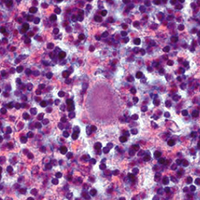Sporadic Creutzfeldt-Jakob disease: Real-Time Quaking Induced Conversion (RT-QuIC) assay represents a major diagnostic advance

Accepted: 7 September 2021
HTML: 24
All claims expressed in this article are solely those of the authors and do not necessarily represent those of their affiliated organizations, or those of the publisher, the editors and the reviewers. Any product that may be evaluated in this article or claim that may be made by its manufacturer is not guaranteed or endorsed by the publisher.
Authors
Sporadic Creutzfeldt-Jakob disease (sCJD) is a rare and fatal neurodegenerative disorder with an incidence of 1.5 to 2 cases per million population/year. The disease is caused by a proteinaceous infectious agent, named prion (or PrPSc), which arises from the conformational conversion of the cellular prion protein (PrPC). Once formed, PrPSc interacts with the normally folded PrPC coercing it to undergo similar structural rearrangement. The disease is highly heterogeneous from a clinical and neuropathological point of view. The origin of this variability lies in the aberrant structures acquired by PrPSc. At least six different sCJD phenotypes have been described and each of them is thought to be caused by a peculiar PrPSc strain. Definitive sCJD diagnosis requires brain analysis with the aim of identifying intracerebral accumulation of PrPSc which currently represents the only reliable biomarker of the disease. Clinical diagnosis of sCJD is very challenging and is based on the combination of several clinical, instrumental and laboratory tests representing surrogate disease biomarkers. Thanks to the advent of the ultrasensitive Real-Time Quaking-Induced Conversion (RT-QuIC) assay, PrPSc was found in several peripheral tissues of sCJD patients, sometimes even before the clinical onset of the disease. This discovery represents an important step forward for the clinical diagnosis of sCJD. In this manuscript, we present an overview of the current applications and future perspectives of RT-QuIC in the field of sCJD diagnosis.
How to Cite

This work is licensed under a Creative Commons Attribution-NonCommercial 4.0 International License.
PAGEPress has chosen to apply the Creative Commons Attribution NonCommercial 4.0 International License (CC BY-NC 4.0) to all manuscripts to be published.
Similar Articles
- Peipei Lu, Shuxiang Li, Caoyang Zhang, Xinyi Jiang, Jinghua Xiang, Hong Xu, Jian Dong, Kun Wang, Yuhua Shi, Spinosin ameliorates osteoarthritis through enhancing the Nrf2/HO-1 signaling pathway , European Journal of Histochemistry: Vol. 68 No. 2 (2024)
- T. Al-dhohorah, M. Mashrah, Z. Yao, J. Huang, Aberrant DKK3 expression in the oral leukoplakia and oral submucous fibrosis: a comparative immunohistochemical study , European Journal of Histochemistry: Vol. 60 No. 2 (2016)
- Fenqiang Qi, Yuxin Deng, Wei Huang, Yanli Cai, Kelin Hong, Shui Xiang, Irisin suppresses PDGF-BB-induced proliferation of vascular smooth muscle cells in vitro by activating AMPK/mTOR-mediated autophagy , European Journal of Histochemistry: Vol. 68 No. 4 (2024)
- Andrea Amaroli, Sara Ferrando, Marina Pozzolini, Lorenzo Gallus, Steven Parker, Stefano Benedicenti, The earthworm Dendrobaena veneta (Annelida): A new experimental-organism for photobiomodulation and wound healing , European Journal of Histochemistry: Vol. 62 No. 1 (2018)
- Zhanshu Ma, Qi Gao, Wenjing Xin, Lei Wang, Yan Chen, Chang Su, Songyan Gao, Ruiling Sun, The role of miR-143-3p/FNDC1 axis on the progression of non-small cell lung cancer , European Journal of Histochemistry: Vol. 67 No. 2 (2023)
- Guangbao He, Yibo He, Hongwei Ni, Kai Wang, Yijun Zhu, Yang Bao, Dexmedetomidine attenuates neuroinflammation and microglia activation in LPS-stimulated BV2 microglia cells through targeting circ-Shank3/miR-140-3p/TLR4 axis , European Journal of Histochemistry: Vol. 67 No. 3 (2023)
- Gianpaolo Antonio Basile, Salvatore Bertino, Alessia Bramanti, Rosella Ciurleo, Giuseppe Pio Anastasi, Demetrio Milardi, Alberto Cacciola, Striatal topographical organization: Bridging the gap between molecules, connectivity and behavior , European Journal of Histochemistry: Vol. 65 No. s1 (2021): Special Collection on Advances in Neuromorphology in Health and Disease
- S Perticarari, M Prodan, E Fragonas, S Canova, G Presani, CD69 expression on a-gliadin-specific T cells in coeliac disease , European Journal of Histochemistry: Vol. 46 No. 1 (2002)
- Kazuhiko Hashimoto, Yutaka Oda, Fumihisa Nakamura, Ryosuke Kakinoki, Masao Akagi, Lectin-like, oxidized low-density lipoprotein receptor-1-deficient mice show resistance to age-related knee osteoarthritis , European Journal of Histochemistry: Vol. 61 No. 1 (2017)
- Guillermo Laguna-Hernández, Carlos A. Rio-Zamorano, Itzel G. Meneses-Ochoa, Alicia E. Brechú-Franco, Histochemistry and immunolocalisation of glucokinin in antidiabetic plants used in traditional Mexican medicine , European Journal of Histochemistry: Vol. 61 No. 2 (2017)
<< < 12 13 14 15 16 17 18 19 20 21 > >>
You may also start an advanced similarity search for this article.

 https://doi.org/10.4081/ejh.2021.3298
https://doi.org/10.4081/ejh.2021.3298










